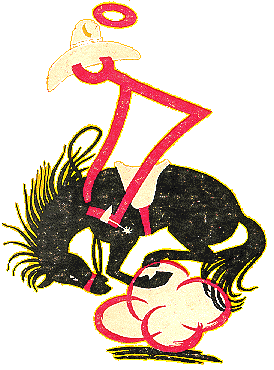|

Article Page 1
Article Page 2
Article Page 3
Article Page 4
Article Page 5
Bibliography
Cover Gallery 1
Cover Gallery 2
Cover Gallery 3
Cover Gallery 4
Cover Gallery 5
Cover Gallery 6
Cover Gallery 7
German covers by Regino Bernad
Le Saint Detective Magazine 1
Le Saint Detective Magazine 2
Le Saint Detective Magazine 3
Le Saint Detective Magazine 4
About Nero Wolfe & The Toff
About artist
Regino Bernad
The Saint on French Radio
French-English
Text Comparisons
De Saint (The Dutch Saint)

© 2001 Jean-Marc Lofficier. This article first appeared in a slightly different form in the Summer '94 issue
of The Epistle.
Thanks to Ian Dickerson for Research Assist.
Thanks to Dan Bodenheimer, Marcel Bernadac, and Patrick Verdant for additional cover scans.

|
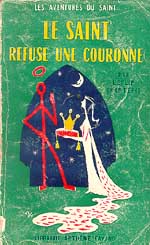 3. The "comic stories"- first period (1954-1959) 3. The "comic stories"- first period (1954-1959)
The first story adapted from the NYH-T comic-strip was No. 34, The Saint Refuses a Crown, in which Simon helps Elaine Valdor, heir to the crown of Roldavia, regain her throne
and defeat Prince Hugo and villainous financier Lord Bullfish. At the end, Simon turns down her offer to become
her consort. Barer quotes Charteris (page 401) as saying that, in the original story which he wrote, the fictional
Ruritania-like country was called Valdor, and he was displeased by the decision of the French editors to rename
it Roldavia.
Unlike what is stated in Barer's book (page 402), the next French Saint pastiche, No. 35, The Saint Battles a Phantom, was not, at last entirely, based on a NYH-T comic-strip. A careful review of the plot shows that it incorporated elements from two
radio scripts, Ken Crossen's With No Tomorrow
and Louis Vittes' The Case of the Unkindest Cut,
with some additional material which, if not new, may or may not have come from the NYH-T. In this story, drug kingpin Warner Wilson uses Simon to eliminate his four partners:
Lane, Becker, Harlan and Henley, so that all the profits from their traffic will remain his alone.
This plot is remarkably similar to that of The Saint in New York -- a fact pointedly acknowledged by Michel-Tyl who, at the end of the book, inserted a
line of dialog in which Simon tells the villain that "once in New York, someone tried to play the same trick
on him; he was called the Big Man and he died on the electric chair." The rest of the plot revolves around
the Crestview medical facility and Lane's use of Chinese coffins to smuggle drugs.
The titles of No. 35 translates as The Saint Battles a Phantom and that of No.36 as The Saint Discovers Virus
13, although the title pages of each book bears a mention of different
original English titles, respectively The Saint Meets a Ghost and The Saint Takes Germs.
This is almost a unique occurrence, which will be repeated only once more, with No. 46, The
Saint Meets a Flying Saucer.
In the absence of a comprehensive list of synopses of the NYH-T strips equivalent to Barer's list of radio script synopses, to which the reader could
easily refer, I have elected to provide here brief plot summaries of the French NYH-T pastiches, which may then help those familiar with the strips to match the French novels
with their "sources". Certainly, the concept of comic-strips being turned into novelizations remains
unique to this day.
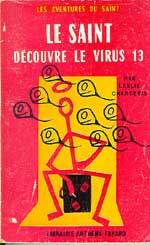 In The Saint Discovers Virus 13 (No. 36), Simon fights
a nazi scientist, Anton Morgan, and his beautiful, blonde wife, Greta, to prevent the release of the deadly Virus
13. Simon eventually kills Anton but Greta escapes with the money. Greta went on to become a regular opponent in
the series, returning in Nos. 43, 47, 53, 62 and 75. She is very much in love with Simon, and always tries to seduce
him into joining her nefarious schemes. Naturally, Simon always refuses, at which point Greta, somewhat reluctantly,
one feels, attempts to kill him. Conversely, Simon does not seem displeased when, at the end of each novel, Greta
manages to escape from the Law. In The Saint Discovers Virus 13 (No. 36), Simon fights
a nazi scientist, Anton Morgan, and his beautiful, blonde wife, Greta, to prevent the release of the deadly Virus
13. Simon eventually kills Anton but Greta escapes with the money. Greta went on to become a regular opponent in
the series, returning in Nos. 43, 47, 53, 62 and 75. She is very much in love with Simon, and always tries to seduce
him into joining her nefarious schemes. Naturally, Simon always refuses, at which point Greta, somewhat reluctantly,
one feels, attempts to kill him. Conversely, Simon does not seem displeased when, at the end of each novel, Greta
manages to escape from the Law.
No. 37, entitled The Saint Plays with Fire
(not to be confused with No. 15), takes place in Florida, with the character of Sheriff Haskins (from No. 17) making
a return appearance. In it, Simon, Patricia and Hoppy foil a scheme by circus operator Candy Gangelin and lion-tamer
Otto to kidnap and ship out scientists.
In the next volume, The Saint vs. the Triangle
(No. 38), Simon helps Mary Green fight the villainous Hal Goss and two other criminals known as the Triangle for
the secret of a gold mine which she stands to inherit from Mr. Fergus, a dying outlaw who was her grandfather's
former business partner. The story takes place in Nevada.
The title of No. 39 said it all: The Saint at the Carnival of Rio. In it, Simon, Patricia and Hoppy fight a famous forger named Magorsky who has taken refuge
in Brazil.
Strangely, the next novel was a return to the radio "fix-ups" of the previous period. Entitled The Saint and the Green Parakeet (No. 40), it
made use of two Louis Vittes radio scripts: The Case of the Lopsided Triangle and The Case of the Indiscreet Parakeet, as well as other material, presumably borrowed from the NYH-T. In it, Simon defeats Hallister,
the head of A.A.A., a Kansas City publisher of crime novels, who blackmails murderers. A green parrot named Oscar
provides a vital clue.
(For the record, Dutch publisher A. W. Bruna & Zoon ended up translating the following seven French novels:
Nos. 40, 42, 43, 46 to 48 and 50.)
The series then returned to the NYH-T
strip for inspiration. Entitled The Saint Condemns Without Appeal, No. 41's plot featured the return of Hamilton, who uses Simon to defeat Noah S. Banson,
the head of the Serpent Ring. Banson is revealed to be a foreign spy plotting to set up an enemy base near Pearl
Harbor. In a somewhat unusual departure for novels of this period, the Saint actually executes the villain at the
end of the story.
In the next book, The Saint Chooses a Painless Death
(No. 42), Simon outwits D.F.Jakes, who first offers would-be suicidees a painless death, arranges for them to regain
their taste for life, and then threatens to go though with his end of the contract unless they pay him ransom money.
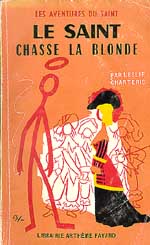 Greta Morgan returned
in No. 43, The Saint Hunts for the Blonde,
not one of Michel-Tyl's best efforts. In this rather plodding novel, taking place in Los Angeles, Simon encounters
Olga Ramos, a.k.a. Greta Morgan, and prevents her from stealing the money that Juan Lobo, a Banana Republic President,
is planning to steal before his people kick him out. Greta Morgan returned
in No. 43, The Saint Hunts for the Blonde,
not one of Michel-Tyl's best efforts. In this rather plodding novel, taking place in Los Angeles, Simon encounters
Olga Ramos, a.k.a. Greta Morgan, and prevents her from stealing the money that Juan Lobo, a Banana Republic President,
is planning to steal before his people kick him out.
In the following volume, The Saint Plays Nursemaid
(No. 44), Simon foils the plans of Big Tony, a gangster who is determined to do everything in his power so that
his daughter, Lizza, who is unaware of his identity, is happy.
No. 45, much to the average fan's surprise, turned out to be a straightforward translation of Charteris' own collection,
The Saint in Europe.
The next book, The Saint Meets a Flying Saucer
(No. 46), by contrast, was yet another uninspired NYH-T plot, in which Simon exposes the villainous Dr.Quale who has built a fake flying saucer
to extort money from people who believe they have been contacted by an alien named Xot.
The series picked up again with The Saint Becomes a Pirate (No. 47), in which Greta Morgan uses a drug to brainwash the Saint, who then helps her
run a pirate ring in the Atlantic. Eventually, Simon, free of the drug's influence, foils her plan to ransom Greek
millionaire Kyros Chrysos.
No. 48, entitled The Saint Requests the Head,
had the feel of a "fix-up", assembled by Michel-Tyl from three, previously unconnected stories. However,
it was not derived from any of the radio scripts. In the first story, the Saint defeats a beauty institute scam
in Hollywood. Then, he exposes a blackmailing newspaper, "Dig", and his crooked owner, Grubb. Finally,
he uncovers the "head" behind all these rackets: a crooked Sacramento lawyer named Rex Ficks.
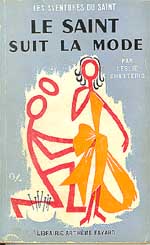 The next volume,
The Saint Follows the Fashion
(No. 49), proved to be one of Michel-Tyl's best efforts during this period. In it, Simon defeats a fashion designer,
Valentine, who uses hi-fi equipment to simulate an enemy air attack over London in order to stage a giant burglary.
The plot is almost science-fiction. The novel also introduced the only other returning "companion" --
excluding the Charteris-created regulars, such as Patricia Holm, Hoppy Uniatz, etc. -- Joelle Darcenay, a French
journalist. Miss Darcenay made a reappearance in No. 53, and considering her considerable charm and spunk, it is
a shame that she was not chosen to appear more often in the series. The next volume,
The Saint Follows the Fashion
(No. 49), proved to be one of Michel-Tyl's best efforts during this period. In it, Simon defeats a fashion designer,
Valentine, who uses hi-fi equipment to simulate an enemy air attack over London in order to stage a giant burglary.
The plot is almost science-fiction. The novel also introduced the only other returning "companion" --
excluding the Charteris-created regulars, such as Patricia Holm, Hoppy Uniatz, etc. -- Joelle Darcenay, a French
journalist. Miss Darcenay made a reappearance in No. 53, and considering her considerable charm and spunk, it is
a shame that she was not chosen to appear more often in the series.
The next book, entitled First Prize for the Saint
(No. 50), was a clever yarn in which Simon defeats New York forger Spats Lieber who plans to use a phony game show
to launder fake US bonds, with the unwitting complicity of actor/host Tag Tower.
It was followed by yet one more straightforward translation of a Charteris' short story collection: The Saint on the Spanish Main.
No. 52, entitled I Accuse the Saint,
was likely a "fix-up" created out of two stories which just happened to both take place in California.
In the first, taking place in San Francisco, the Saint fights a racket preying on Chinese families. Then, the action
moves to Hollywood, where Simon outwits movie producer Joe Nemo, who tries to frame him in a diamond robbery case.
Naturally, Nemo turns out to have been behind the Chinese racket as well.
Joelle Darcenay returned to help Simon do battle with no less than Greta Morgan once again in No. 53, Greta Wraps up The Saint. In this rather disjointed
effort (another "fix-up"?), Simon follows Greta's trail to France, and then to North Africa, where he
ends up leading a slave rebellion against Greta and her allies, gun merchant Horace Dumet and the evil Ivanoff.
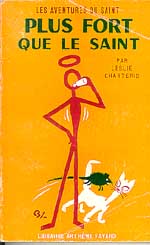 The title of the
next novel translates as Stronger than the Saint
(No. 54), but it is a version of Bet on the Saint.
This is not a translation of the Fleming Lee version as Lee had not met Leslie in 1958. The stories are the same
because they share the same source material, i.e.: a Herald-Tribune comic strip. Michel-Tyl novelized the French
version while Lee produced an English language version some years later. The background of the Charteris/Lee collaboration
on Bet on the Saint is covered
in Burl Barer's book (pages 171-176). This French version is therefore the only published version of this source
story. The title of the
next novel translates as Stronger than the Saint
(No. 54), but it is a version of Bet on the Saint.
This is not a translation of the Fleming Lee version as Lee had not met Leslie in 1958. The stories are the same
because they share the same source material, i.e.: a Herald-Tribune comic strip. Michel-Tyl novelized the French
version while Lee produced an English language version some years later. The background of the Charteris/Lee collaboration
on Bet on the Saint is covered
in Burl Barer's book (pages 171-176). This French version is therefore the only published version of this source
story.
Bet on the Saint was followed
by Hurrah for the Saint (No. 55),
a very odd book which read like a quickly-assembled "fix-up" of two stories. In its first part, Simon
fights New York crime "bourgeois" Leo Garmish and his lieutenant Halber over the murder of a journalist.
The character of Midnight, an enigmatic female antagonist, is introduced. At the end of part one of the book, Michel-Tyl
then inserted a note to tell his readers that the events from Nos. 53 and 54 took place here and prevented Simon
from completely wrapping up the case, i.e.: putting Leo out of commission. In part two, the action then moves to
the French Riviera, where Simon, disguised as a Maharajah, foils Garmish's attempt to rob a Casino. Midnight, too,
is back, but she is finally revealed to have been working for Fernack all the time.
Hamilton returned in No. 56, The Spectre of the Saint,
in which he employs Simon to unmasks a California spy ring led by Raab, Dancey and Hilda Shane. The three villains
throw the Saint into the Pacific Ocean, but he escapes drowning and pretends to be dead. He then returns to spook
them up into surrendering.
This book was followed by a translation of Charteris' 1956 collection, The
Saint Around The World (released in France in 1959).
For reasons discussed in our next chapter, the quality and interest of the French pastiches then went up markedly,
with some of the most interesting books published later in the series.
PART 4 TO BE CONTINUED ON NEXT PAGE:

|
